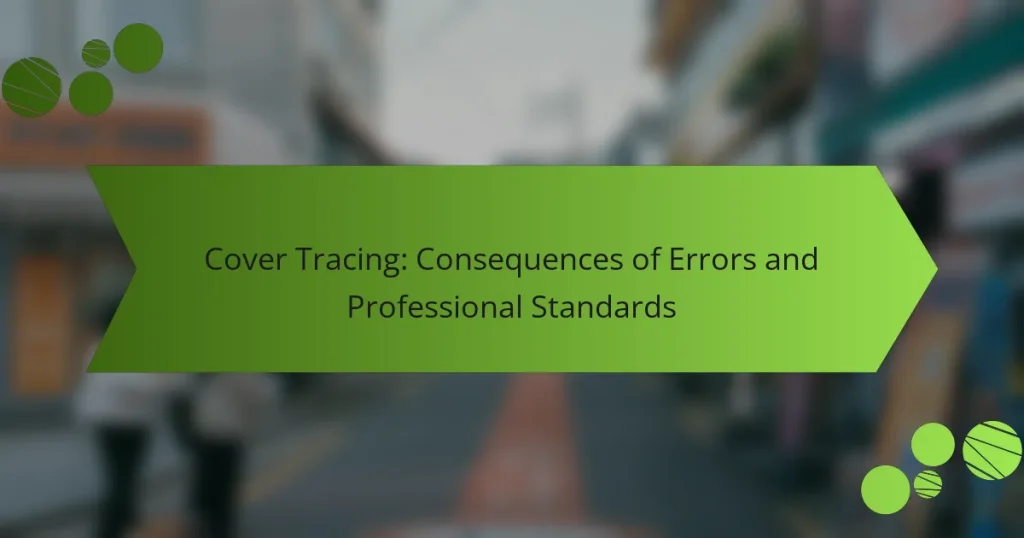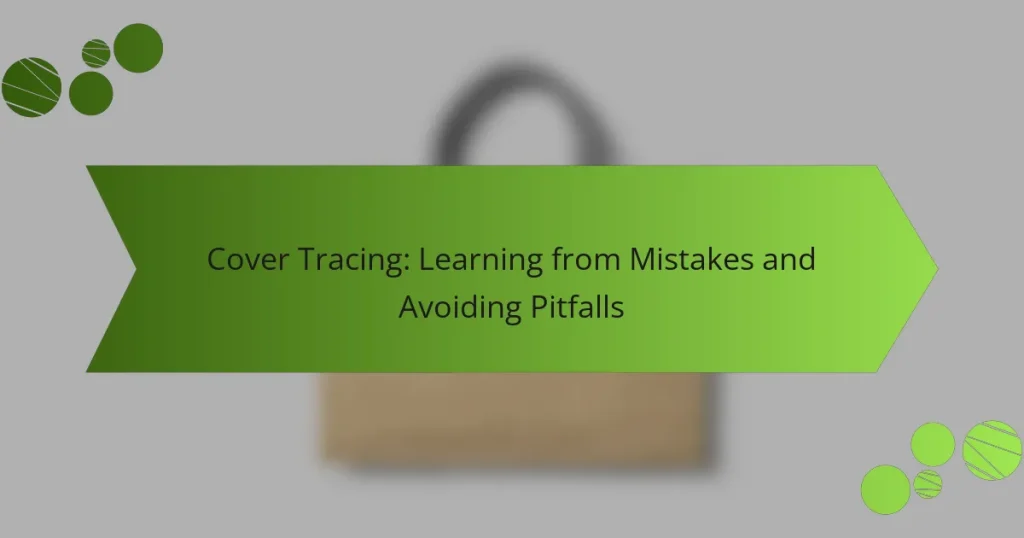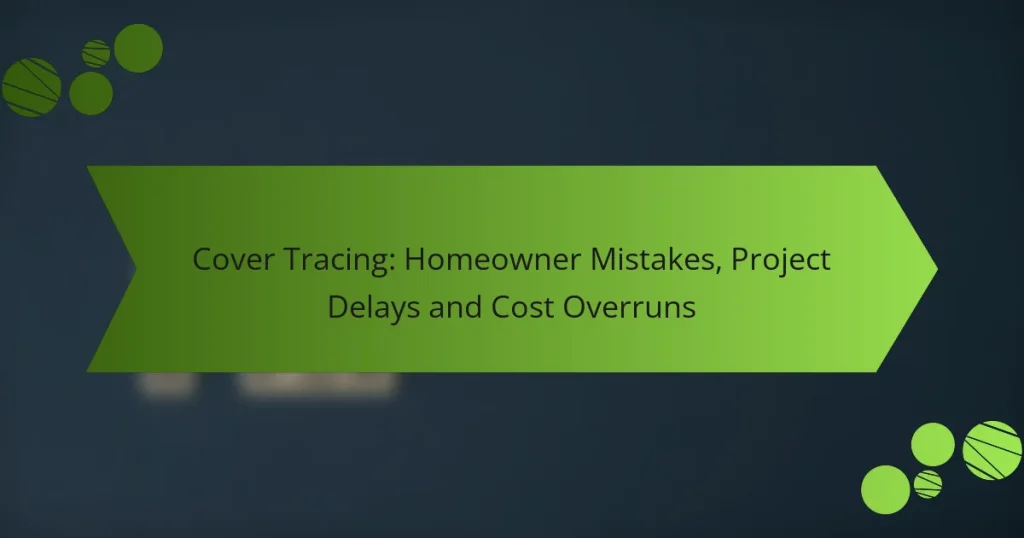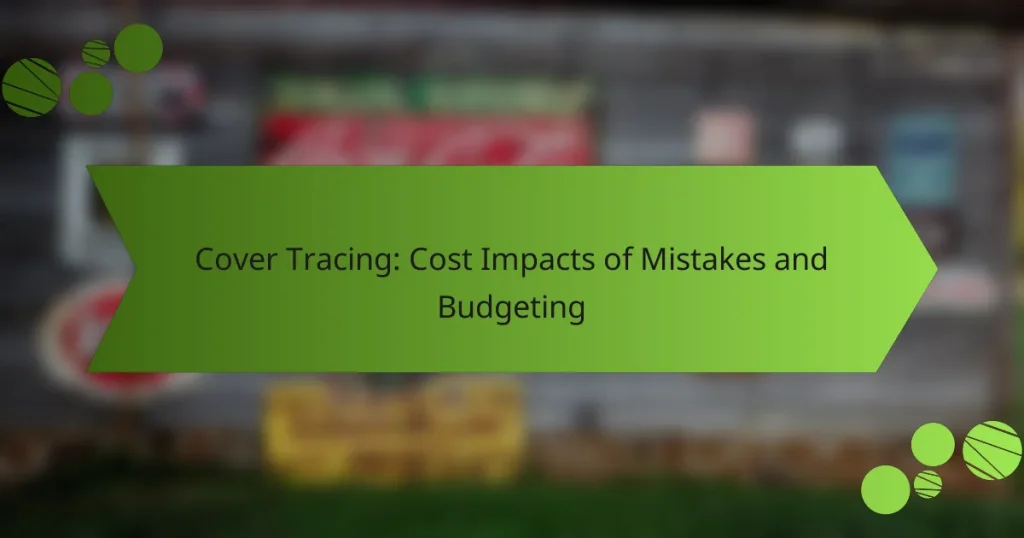Cover tracing is a critical process that requires precision and attention to detail. Common mistakes, such as inaccurate measurements and poor material choices, can compromise the final product’s functionality and compliance. By understanding these pitfalls and employing the right tools, you can enhance accuracy and achieve better results.
Cover Tracing: Consequences of Errors and Professional Standards
Cover Tracing: Identifying Errors and Quick Fixes
Cover Tracing: Common Mistakes and Better Results
Cover Tracing: Learning from Mistakes and Avoiding Pitfalls
Cover Tracing: Homeowner Mistakes, Project Delays and Cost Overruns
Cover Tracing: Cost Impacts of Mistakes and Budgeting
What are the common cover tracing mistakes?
Common cover tracing mistakes include errors in measurements, poor material choices, lack of planning, neglecting environmental factors, and ignoring local regulations. These mistakes can lead to significant issues in the final product, affecting both functionality and compliance.
Incorrect measurements
Incorrect measurements are a frequent mistake in cover tracing, often resulting from miscalculations or misinterpretations of dimensions. It’s crucial to double-check all measurements against the original specifications to ensure accuracy.
Using tools like laser distance meters can help improve precision. Always account for tolerances in your measurements, as small discrepancies can lead to larger issues during installation.
Poor material selection
Choosing the wrong materials can compromise the durability and effectiveness of the cover. Factors such as climate, exposure to elements, and intended use should guide material selection.
For example, using a lightweight plastic cover in a high-wind area may lead to damage or failure. Consider consulting material specifications and performance ratings to make informed choices.
Inadequate planning
Inadequate planning can result in unforeseen complications during the installation process. A thorough plan should outline all steps, resources, and timelines to avoid delays and additional costs.
Creating a checklist of necessary tools and materials can help streamline the process. Additionally, involving all stakeholders early in the planning phase can ensure that everyone is aligned on expectations and responsibilities.
Neglecting environmental factors
Environmental factors, such as local weather conditions and terrain, can significantly impact the performance of a cover. Failing to consider these elements may lead to premature wear or failure of the cover.
For instance, in areas prone to heavy rainfall, selecting a water-resistant material is essential. Conducting a site assessment can help identify specific environmental challenges to address in your design.
Ignoring local regulations
Ignoring local regulations can lead to legal issues and costly fines. It’s vital to be aware of any building codes or zoning laws that may apply to your cover installation.
Researching local requirements before starting the project can save time and resources. Consulting with local authorities or a compliance expert can ensure that your project meets all necessary standards and regulations.
How can you fix cover tracing mistakes?
Fixing cover tracing mistakes involves careful review and adjustments to ensure accuracy. Start by verifying measurements, selecting the right materials, and planning thoroughly to avoid common errors.
Double-check measurements
Accurate measurements are crucial in cover tracing to prevent costly mistakes. Always measure twice and consider using a laser measuring tool for precision. If possible, compare your measurements with existing structures to confirm their accuracy.
Common pitfalls include overlooking small discrepancies that can lead to significant issues later. Establish a checklist to ensure all dimensions are accounted for and verify them against your project specifications.
Choose appropriate materials
Selecting the right materials is essential for the durability and effectiveness of your cover tracing project. Consider factors such as weather resistance, weight, and compatibility with existing structures. For example, using waterproof materials in humid climates can prevent deterioration.
Research different options and their properties to make informed choices. Avoid materials that are too heavy or unsuitable for your specific application, as they can lead to structural failures or increased maintenance costs.
Develop a detailed plan
A comprehensive plan is vital to guide your cover tracing project and minimize errors. Outline each step, including timelines, resources needed, and potential challenges. This will help you stay organized and focused throughout the process.
Incorporate visual aids, such as diagrams or sketches, to clarify your intentions. Regularly review and adjust your plan as needed to accommodate any changes or unexpected issues that arise.
Consider environmental impacts
Understanding the environmental impacts of your cover tracing project is essential for sustainability. Assess how your choices affect local ecosystems, including soil erosion, water runoff, and wildlife habitats. Aim to minimize negative effects by selecting eco-friendly materials and practices.
For instance, using permeable materials can help manage water drainage effectively. Always consider the long-term implications of your project on the environment and strive for solutions that promote ecological balance.
Research local regulations
Familiarizing yourself with local regulations is critical to ensure compliance and avoid legal issues. Different regions have specific codes regarding construction, zoning, and environmental protection that must be adhered to during your cover tracing project.
Consult local authorities or building departments to obtain the necessary permits and understand any restrictions. This proactive approach can save you time and resources, preventing potential fines or project delays.
What tools can help improve cover tracing accuracy?
Several tools can significantly enhance the accuracy of cover tracing, including laser measuring devices, 3D modeling software, Geographic Information Systems (GIS), and surveying equipment. Each tool offers unique features that can help streamline the tracing process and reduce errors.
Laser measuring devices
Laser measuring devices provide precise distance measurements using laser technology, which can improve cover tracing accuracy. These devices typically measure distances within a few millimeters, making them ideal for detailed work.
When using laser measuring devices, ensure that the surface is reflective enough for accurate readings. Avoid using them in bright sunlight or on uneven surfaces, as these conditions can lead to measurement errors.
3D modeling software
3D modeling software allows users to create detailed digital representations of physical spaces, which can assist in cover tracing. This software can visualize complex structures and help identify potential issues before physical tracing begins.
When selecting 3D modeling software, consider compatibility with existing tools and ease of use. Popular options often include features for collaboration and real-time updates, which can enhance team efficiency.
Geographic Information Systems (GIS)
Geographic Information Systems (GIS) are powerful tools for mapping and analyzing spatial data, which can greatly aid in cover tracing. GIS can integrate various data layers, allowing for comprehensive analysis of geographical features and their relationships.
Utilizing GIS effectively requires familiarity with its functionalities. Ensure that the data used is up-to-date and relevant to your project, as outdated information can lead to inaccuracies in cover tracing.
Surveying equipment
Surveying equipment, such as total stations and theodolites, provides high-precision measurements for land and construction projects, enhancing cover tracing accuracy. These tools are essential for establishing reference points and ensuring that measurements are consistent.
When using surveying equipment, proper calibration and setup are crucial. Regular maintenance and training on equipment usage can prevent common pitfalls and improve overall accuracy in cover tracing tasks.
What are the best practices for cover tracing?
Best practices for cover tracing involve careful planning and execution to minimize errors. Key strategies include conducting thorough site assessments, engaging with local experts, and utilizing technology effectively.
Conduct thorough site assessments
Thorough site assessments are crucial for accurate cover tracing. This process involves evaluating the geographical and environmental conditions of the area, which can significantly impact the tracing results. Consider factors such as soil type, vegetation, and existing infrastructure.
Before starting, gather relevant data from local authorities or previous studies. This information will help identify potential challenges and inform your tracing strategy. Regularly update your assessments to reflect any changes in the site conditions.
Engage with local experts
Engaging with local experts can enhance the quality of your cover tracing efforts. These professionals often have valuable insights into the specific challenges and nuances of the area, which can lead to more accurate results. They can also provide guidance on local regulations and best practices.
Consider forming partnerships with local universities, environmental organizations, or government agencies. This collaboration can facilitate knowledge sharing and access to resources that may not be readily available otherwise.
Utilize technology effectively
Utilizing technology effectively is essential for modern cover tracing. Tools such as GIS (Geographic Information Systems) and remote sensing can provide detailed spatial data that enhances your assessments. These technologies can help visualize data and identify patterns that might not be apparent through traditional methods.
Invest in training for your team to ensure they can leverage these technologies to their full potential. Regularly review and update your technological tools to keep pace with advancements in the field, ensuring your tracing methods remain efficient and accurate.






